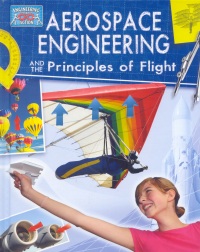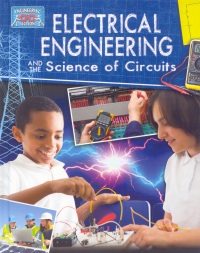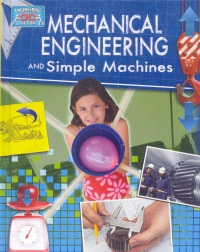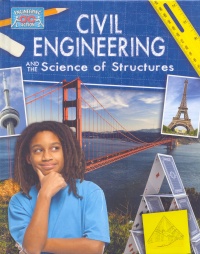| ________________
CM . . .
. Volume XIX Number 31. . . .April 12, 2013
excerpt:
According to the promotional materials that accompanied this quartet of books, the "Engineering Action" series was "[c]reated to support the 2012 Conceptual Framework for K-12 Science Education standards...." The series "connects readers with the technology that surrounds them in their everyday lives. The series is designed to spark new ideas, build critical and creative thinking skills, and inspire interest and enthusiasm for STEM careers." Given that the 2012 Conceptual Framework referred to above is an American document, Canadian educators will need to decide exactly where and how this series, which is aimed at a middle school audience, fits into their provincial science curricula. Those who are familiar with Crabtree series books will immediately recognize the house's oft-utilized format. Following a table of contents page, the book’s major contents are divided into titled "chapters" with each chapter consisting of a pair of facing pages. In the "Engineering in Action!" series, there are 13 such chapters. Each book concludes with a "Learning more" page that directs readers to books, websites and, with the exception of Civil Engineering and the Science of Structures, "Places to Visit". On the surface, suggesting places to visit is a good idea, but how likely is it that someone in Halifax, Winnipeg or Vancouver will be intentionally traveling to The Works in Minneapolis, MN, the Exploratorium in San Francisco, CA or the Welland Canals Centre in St. Catharines, ON? As is Crabtree’s practice, words that have been bolded in the text are defined in a one-page glossary, and each book concludes with a one-page index. Generously illustrated with full-colour photos and diagrams, the books' texts are presented in both regular font and in what appears to be hand-printed text on pages taken from a lined yellow legal pad. As would be expected of a series, by and large, each book presents its content in a similar fashion, and each begins by briefly explaining what the particular type of engineer does in our world. For example, Aerospace Engineering and the Principles of Flight, tells readers that "Aerospace engineers work on the construction of aircraft (aeronautics) and spacecraft (astronautical engineering)" while Electrical Engineering and the Science of Circuits explains that "Electrical engineers are involved with all aspects of electricity. They know how to make electricity, how to bring it to where it's needed, how to store it, and how to make it work." Much of each book is then given over to the eight-step process that apparently all types of engineers use to carry out their work: 1. Identify the problem. 2. Identify criteria and constraints. 3. Brainstorm possible solutions. 4. Select a design. 5.Build a model or prototype. 6. Test the model. 7. Refine the design. 8. Share the solution. Using a problem appropriate to each of the four engineering types, the authors, via separate chapters, then take readers through each of these eight steps to illustrate how engineers implement the process. Ultimately, each book presents readers with an "engineering" problem to be solved and asks them to use the eight steps in solving it. For instance, the challenge for readers in Mechanical Engineering and Simple Machines asks: "Can you design and make a model car with a built-in power source that will provide the force to make it move?" While the challenge has many solutions, unfortunately, for most readers, the process will be short-circuited because the problem is accompanied by an illustration that offers two "answers." On the other hand, the challenge in Electrical Engineering and the Science of Circuits, to make a telegraph, is too vague. "You have buzzers, batteries, wire and tape, as well as blocks of wood, screws and paper clips. can you build your won telegraph network?" ("Not likely!" will be most middle schoolers' responses.). The challenge in Aerospace Engineering and the Principles of Flight is "to build a glider that will fly smoothly." Again, illustrations accompanying the challenge might limit the brainstorming process. Perhaps the "best" challenge is that offered by Civil Engineering and the Science of Structures which says:
Using the materials provided, build a stable structure as tall as possible. The structure has to stand up in the breeze from an electric fan. The materials you can use in the challenge are:
For those unfamiliar with the acronym STEM that was used in the first paragraph of this review, it stands for science, technology, engineering and mathematics, and the term STEM careers refers to America's (and other countries') desire to attract more people into these occupational areas, with, perhaps, a special emphasis on attracting more females into the pure and applied sciences. To some limited degree, the "Engineering in Action!" series does reinforce the idea of interesting more women in engineering careers as each of the covers features a young girl in its design. However, the carryover of female participation into the content of the books is uneven. The best expression of women in engineering is found in Electrical Engineering and the Science of Circuits where a whole page is given over to eight female electrical engineers while Aerospace Engineering and the Principles of Flight devotes almost a half page to Canadian "Julie Payette - Engineer and Astronaut". The other two books, while they do contain photos that include females, make no mention of any female civil or mechanical engineers. In Crabtree's choosing photos that are supposed to encourage young women to consider STEM careers, more care must be taken to show females engaged in active, as opposed to passive, roles. Loosely speaking, these four volumes do have a career guidance focus, but they are really more about aspects of science that are particularly connected to each engineering area, and that connection is identified in the portion of the title that comes after the and. Mechanical Engineering and Simple Machines, for example, utilizes almost a quarter of its length to describe "simple machines". Because each of the engineering areas is so vast in its scope, these volumes can only provide a brief overview of what each type of engineer does, but that might be sufficient to encourage some middle school readers to seek out other resources. Recommended with reservations. Dave Jenkinson, CM's editor, lives in Winnipeg, Manitoba home of the Manitoba Electrical Museum & Education Centre, that was mentioned among the "Places to Visit" in Electrical Engineering and the Science of Circuits.
To comment
on this title or this review, send mail to cm@umanitoba.ca.
Copyright © the Manitoba Library Association. Reproduction for personal
use is permitted only if this copyright notice is maintained. Any
other reproduction is prohibited without permission.
NEXT REVIEW |
TABLE OF CONTENTS FOR THIS ISSUE
- April 12, 2013.
AUTHORS |
TITLES |
MEDIA REVIEWS |
PROFILES |
BACK ISSUES |
SEARCH |
CMARCHIVE |
HOME |



